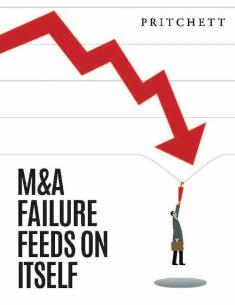The merger is a major distraction for people in the acquired organization. It interferes with their work focus and undermines job commitment. This, plus the destabilization that is simply generic to mergers, causes productivity to take a damaging hit during the transition period.
Our experience indicates that employee productivity in a newly acquired or merged company gets cut in half during the first several months of an integration. Some companies do better than this, of course, but almost always there is a sharp decline in productivity during the early stages.
Sagging productivity would be enough of a problem, but it leads to a secondary dilemma: failure feeds on itself. When employees see obvious slippage in organizational momentum, they often interpret that as evidence that it’s a “bad merger” or that top management is doing a poor job of handling the situation.
Interestingly, the destabilization caused by a merger powerfully increases the energy level in a company. But unless that energy gets channeled along productive lines, it’s a destructive force that can sabotage corporate effectiveness.
We recommend these 7 ground rules to follow:
- Operate with very short-range goals or objectives.
- Initiate new, merger-specific incentive programs for the transition period.
- Monitor performance more closely.
- Provide employees quick, accurate feedback regarding shortfalls in their performance effectiveness.
- Pass out more “psychological paychecks” (i.e. sincere appreciation, praise) to people who are excelling.
- Move quickly to clarify roles and responsibilities for each employee.
- Even though you may secretly be expecting less from your people, ask for more. Actually, raise the performance standards.
Just as failure feeds on itself, success breeds success. So keep the pressure on to protect, even enhance, productivity levels.





